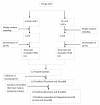Examining appropriate diagnosis and treatment of malaria: availability and use of rapid diagnostic tests and artemisinin-based combination therapy in public and private health facilities in south east Nigeria
- PMID: 20712876
- PMCID: PMC2931470
- DOI: 10.1186/1471-2458-10-486
Examining appropriate diagnosis and treatment of malaria: availability and use of rapid diagnostic tests and artemisinin-based combination therapy in public and private health facilities in south east Nigeria
Abstract
Background: Rapid diagnostic tests (RDTs) and Artemisinin-based combination therapy (ACT) have been widely advocated by government and the international community as cost-effective tools for diagnosis and treatment of malaria. ACTs are now the first line treatment drug for malaria in Nigeria and RDTs have been introduced by the government to bridge the existing gaps in proper diagnosis. However, it is not known how readily available these RDTs and ACTs are in public and private health facilities and whether health workers are actually using them. Hence, this study investigated the levels of availability and use of RDTs and ACTs in these facilities.
Methods: The study was undertaken in Enugu state, southeast Nigeria in March 2009. Data was collected from heads of 74 public and private health facilities on the availability and use of RDTs and ACTs. Also, the availability of RDTs and the types of ACTs that were available in the facilities were documented.
Results: Only 31.1% of the health facilities used RDTs to diagnose malaria. The majority used the syndromic approach. However, 61.1% of healthcare providers were aware of RDTs. RDTs were available in 53.3% of the facilities. Public health facilities and health facilities in the urban areas were using RDTs more and these were mainly bought from pharmacy shops and supplied by NGOs. The main reasons given for non use are unreliability of RDTs, supply issues, costs, preference for other methods of diagnosis and providers' ignorance. ACTs were the drug of choice for most public health facilities and the drugs were readily available in these facilities.
Conclusion: Although many providers were knowledgeable about RDTs, not many facilities used it. ACTS were readily available and used in public but not private health facilities. However, the reported use of ACTs with limited proper diagnosis implies that there could be high incidence of inappropriate case management of malaria which can also increase the economic burden of illnesses. Government and donors should ensure constant availability of RDTs in both public and private facilities, so that every treatment with ACTs is accompanied with proper diagnosis.
Similar articles
-
Adherence to malaria diagnosis and treatment guidelines among healthcare workers in Ogun State, Nigeria.BMC Public Health. 2016 Aug 19;16(1):828. doi: 10.1186/s12889-016-3495-x. BMC Public Health. 2016. PMID: 27538947 Free PMC article.
-
Improving rational treatment of malaria: perceptions and influence of RDTs on prescribing behaviour of health workers in southeast Nigeria.PLoS One. 2011 Jan 31;6(1):e14627. doi: 10.1371/journal.pone.0014627. PLoS One. 2011. PMID: 21297938 Free PMC article.
-
The private sector market for malaria rapid diagnostic tests in Nigeria: results of the 2018 market survey.Malar J. 2022 Jun 16;21(1):190. doi: 10.1186/s12936-022-04209-3. Malar J. 2022. PMID: 35710474 Free PMC article.
-
Towards subsidized malaria rapid diagnostic tests. Lessons learned from programmes to subsidise artemisinin-based combination therapies in the private sector: a review.Health Policy Plan. 2016 Sep;31(7):928-39. doi: 10.1093/heapol/czv028. Epub 2015 Apr 9. Health Policy Plan. 2016. PMID: 25862732 Free PMC article. Review.
-
Treating uncomplicated malaria in children: comparing artemisinin-based combination therapies.Curr Opin Pediatr. 2010 Dec;22(6):798-803. doi: 10.1097/MOP.0b013e32833fac44. Curr Opin Pediatr. 2010. PMID: 20844433 Free PMC article. Review.
Cited by
-
Rethinking the Design of Low-Cost Point-of-Care Diagnostic Devices.Micromachines (Basel). 2017 Oct 27;8(11):317. doi: 10.3390/mi8110317. Micromachines (Basel). 2017. PMID: 30400509 Free PMC article.
-
Predictors of malaria Rapid Diagnostic Tests' utilisation among healthcare workers in Zamfara State.PLoS One. 2018 Dec 14;13(12):e0200856. doi: 10.1371/journal.pone.0200856. eCollection 2018. PLoS One. 2018. PMID: 30550562 Free PMC article. Clinical Trial.
-
Knowledge, Attitude, and Practice Related to Malaria Diagnosis among Healthcare Workers in Hospitals: A Cross-Sectional Survey.J Trop Med. 2019 Jun 11;2019:1414079. doi: 10.1155/2019/1414079. eCollection 2019. J Trop Med. 2019. PMID: 31285744 Free PMC article.
-
End malaria for good: a review of current strategies and future novelties for malaria elimination in Nigeria.Malariaworld J. 2018 Mar 1;9:1. eCollection 2018. Malariaworld J. 2018. PMID: 34532244 Free PMC article.
-
A scoping review on the field validation and implementation of rapid diagnostic tests for vector-borne and other infectious diseases of poverty in urban areas.Infect Dis Poverty. 2018 Sep 3;7(1):87. doi: 10.1186/s40249-018-0474-8. Infect Dis Poverty. 2018. PMID: 30173662 Free PMC article.
References
-
- World Health Organization. The Africa Malaria Report 2006. World Health Organization, Geneva; 2006.
-
- Federal Ministry of Health (FMOH) Report of the malaria situation analysis survey conducted in the six zones of Nigeria. FMOH, Abuja, Nigeria; 2000.
-
- Federal Ministry of Health (FMOH) National Antimalarial Treatment Guidelines. National Malaria and Vector Control Division Abuja, Nigeria; 2005.
-
- World Health Organization. World Malaria Report 2008. World Health Organization, Geneva; 2008.
MeSH terms
Substances
LinkOut - more resources
Full Text Sources
Medical


